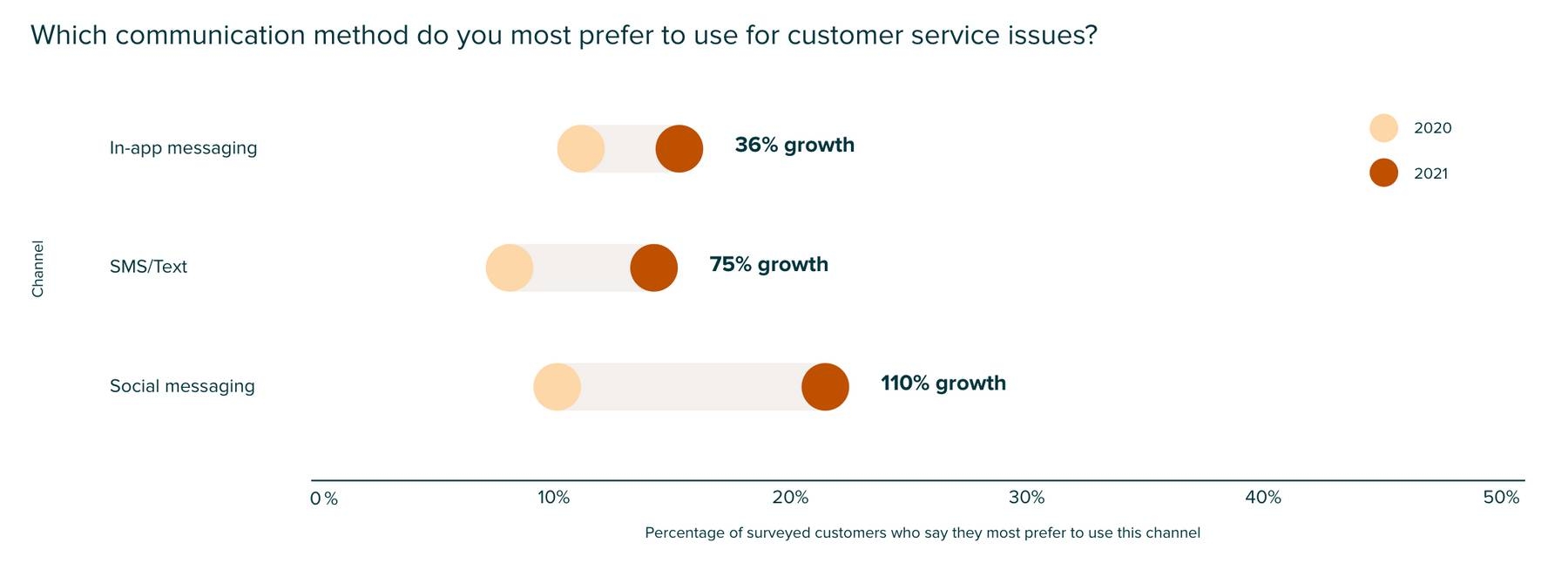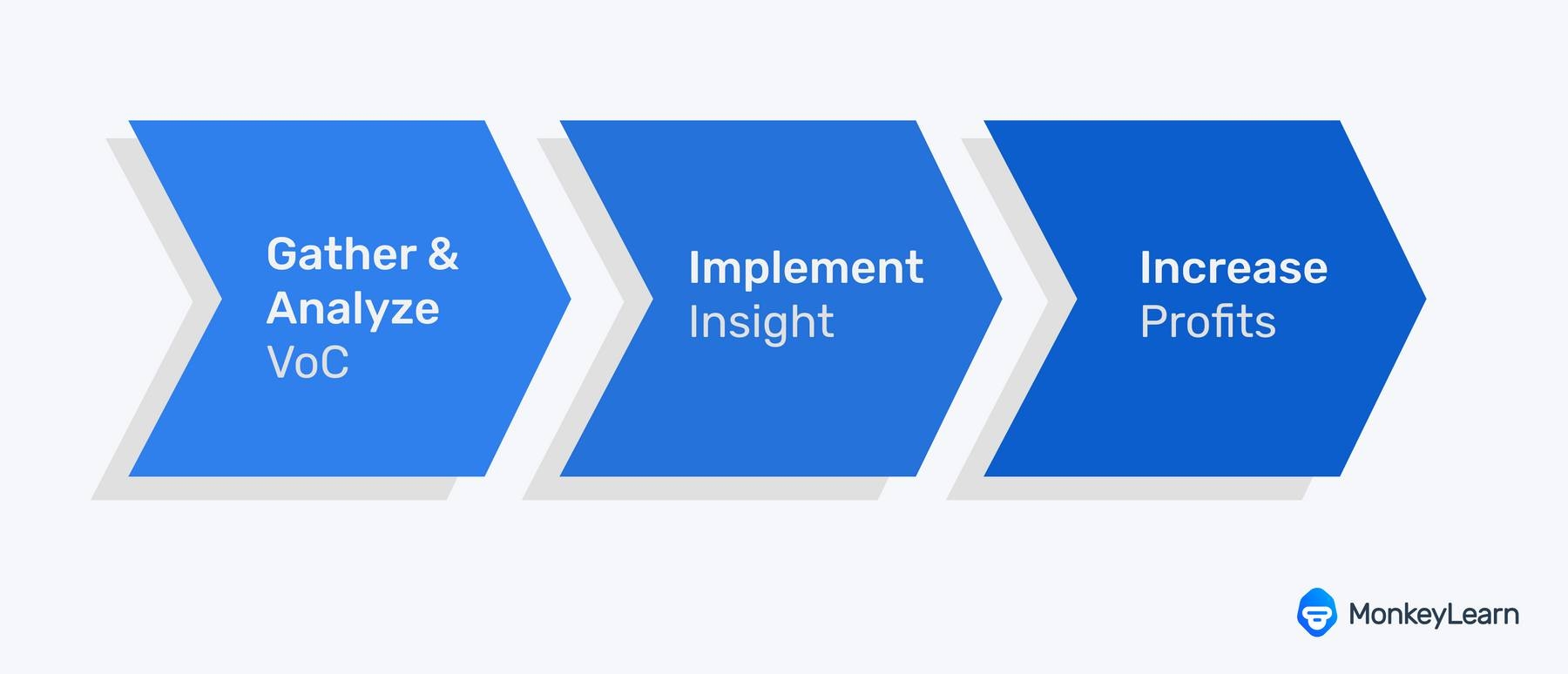How to Use Voice of Customer (VoC) in Your Business

The COVID-19 pandemic has changed the game when it comes to the overall customer experience (CX) and specific customer support needs. As more people work from home (away from their IT teams) and spend more time on computers and devices, they often need immediate support just to get through the work day.
A United Nations study shows that over 50% of respondents shop online more frequently than they did pre-pandemic and rely on the internet more for entertainment and health-related information.
Customers also expect more options and a higher-level of support when reaching out to brands: 64% would rather message a brand than call them. And, of those that use social media for customer service, 18% expect a response immediately and 28% expect it within the hour.
A new CX trends report from Zendesk shows that 64% of customers used a completely new support channel in 2020 and 73% say they’ll continue to use it.

Overall, consumers have more business, product, and service options than ever, so businesses need to find novel ways to engage and retain customers.
Listening to your customers is one way.
Although not a groundbreaking idea, there are novel ways in which you can listen to the people who actually use your products and services. Allow them to guide your strategies, create new features, and help you remain competitive in a saturated market.
Focusing on personalized customer experiences and voice of customer (VoC) in your business will keep your customers satisfied, increase sales, and improve your overall business. But just what exactly is VoC and how does it work?
- What Is VoC in Business?
- Relationship Between VoC and Customer Experience
- How to Use Voice of Customer in Business
- How Businesses Are Using VoC In 2022
What Is Voice of Customer (VoC) in Business?
Voice of customer is the collection and analysis of customer feedback data – opinions, complaints, and compliments – to understand how customers feel about your brand in their own words. VoC gives a solid idea of how customers use your products and services, what they like and don’t like, how your business may be meeting their needs, and what it may be lacking.
Once you learn to properly analyze VoC, you’ll be gathering data from internal systems, surveys, and open opinions from all over the web, for a truly holistic view of your customers (and those of your competition).
More and more companies are adopting VoC programs because they provide the most thorough insights into the customer journey and are the new standard for informing product development, improving product experience (PX), and keeping businesses connected to their customers.
Relationship Between VoC and Customer Experience
What your customers have to say about CX – positive or negative, product feature suggestions, pain points, etc. – is the VoC of your business. And the end goal of VoC is to improve the customer experience with data-driven insights as your guide.
VoC analysis will help you understand where your business excels and what you may need to work on. Improving the customer experience can have a huge impact on customer satisfaction and help increase profits, sometimes almost immediately.

To this point – 86% of customers say they would pay more for a product or service with a better CX and 79% feel that a business’s CX is just as important as its products or services.
Understanding the VoC can lead product managers (PM) to uncover problems with their products and services – and drive improvements and new features that will increase CX.
Furthermore, better customer service is becoming more and more important to customers, and mediocre support is driving them away in droves: 58% of customers say they would end their relationship with a business if they don’t receive the customer service they expect.
Whether it’s on your website, via email or live chat, or interacting with them on social media, you need to be prepared to accept their support inquiries and comments wherever your customers live.
How To Use Voice of Customer in Business
Drive CX Success
Half of customers worldwide say that CX is more important to them now than it was just a year ago. And given the previous statistics, customer support is a major part of CX success. So modern companies need to focus on omnichannel support – both to increase CX and to more thoroughly dig into VoC analysis.
There are many voice of customer tools that can help you automate customer support tasks, for example, to automatically tag, prioritize, route support tickets. Most integrate with tools like Freshdesk, Zendesk, and Service Cloud to ensure that support tickets (or online complaints from across the web) are dealt with immediately, and all of your internal teams are continually aware of support processes and individual ticket management.
Improve Product Development
According to a recent report from Productboard, 52% of product management leaders say that new products and features are mainly inspired by customer feedback, but only 1 in 10 feel that they successfully use all of the available sources of feedback.
There are massive amounts of data available from your internal support systems, online review sites, social media, and all over the internet. Or you can use targeted NPS and CSAT surveys with in-app pop-ups or directly after product interactions to follow CX on a regular basis.
Shape Your Marketing Strategy
Collecting and analyzing customer feedback can increase upselling and cross-selling by 15-20% and companies that implement VoC programs spend 25% less on customer retention.
Following your marketing campaigns on social media can judge what's working and allow you to pivot, when it’s not quite right; and expand your efforts, or celebrate your success across social media when you hit it big.
Techniques like social media sentiment analysis use machine learning to automatically analyze online reactions to marketing campaigns and keyword extraction can uncover new trends in the industry just as they emerge.
How Businesses Are Using VoC in 2022
Take a look at these great use cases of VoC in business.
Anstice
Anstice is a research and marketing consulting group that uses quantitative and qualitative surveys to read into VoC of their clients’ audiences. In a recent project, Anstice used SurveyGizmo to gauge public opinion around building a large infrastructure project.
Leveraging machine learning text analysis techniques, Anstice custom-trained text classification models to automatically organize 14,000 open-ended survey responses by tags according to response subject, respondent demographic, keywords, etc. Next, using custom-trained sentiment analysis models, they were able to automatically classify the comments by opinion polarity: Positive, Negative, Neutral, etc.
This allowed Anstice to save hundreds of hours of manual (and less accurate) analysis to get super fast results and truly understand the VoC of the public to help their client decide the best course of action.
Take a look at MonkeyLearn’s pre-trained sentiment analyzer, to see how it works:
The sentiment analyzer easily classifies this theoretical response as Positive. At 86.8% accuracy is quite high. However, we would expect a custom-trained analyzer to be in the high 90s for a comment such as this.
Ritz-Carlton Hotels
Ritz-Carlton’s President, Herve Humler knows that CX and VoC need to be at the center of every business decision, especially when you work in hospitality. One way to go the extra mile is to empower employees to offer the best CX they can, and allow them to listen to VoC on a person-to-person basis
Humler says: “The attitude I strive to get across to my employees is this: ‘You are not servants, because unlike a servant, I want you to be engaged with the customer – you have a brain, you have a heart and I want you to use them.’ This is why we say, and have always said, that we are ladies and gentlemen serving ladies and gentlemen.
We mean this. I believe in the power of recognition and empowerment leading to great employee engagement. And employee engagement is critical to guest engagement. Employee empowerment and recognition is the core of our culture and how we achieve outstanding service.”
Buffer
Buffer is an app designed to manage social media accounts and analyze engagement for their customers. Buffer refers to their customer support employees as the Happiness Team, a reimagining of customer service that presupposes the overarching business goal is to make their customers happy.
They don’t just aim to put out fires or ensure that their customers are adequately educated with their product, they want to have personal relationships with their customers:
“We view every interaction that comes our way – every email, tweet, question, review, mention and more – as a true privilege. We know that it means someone took special time out of their day to think about us or get in touch with us. It’s a chance for us to have a conversation, to learn something we didn’t know before, to think about what we could do differently or better.
With that in mind, our goal is to make sure each of these interactions is special, unique and as happy as possible.”
Taking the time for individual interactions with customers allows for a personalized service that can vastly decrease customer churn and turn moderately satisfied customers into promoters of your brand.
Dell
Once you’ve built your VoC program, you can use similar techniques to dig into VoE (voice of employee) to understand the employee experience and uncover pain points to increase productivity and overall employee satisfaction. Dell, for example, used machine learning to analyze their annual employee surveys, analyzing 10,000+ open-ended comments and saving hundreds of hours to improve their employees’ day-to-day in the office.
The Wrap Up
It’s evident that VoC is important to every business, and incorporating a VoC program will help you understand your customers, improve your products and service, and increase profits. In this day and age, customers expect communication to be seamless and CX to be a major part of any business.
Building a VoC program may seem daunting, but when you put the right tools in place, it can be a fairly easy undertaking. MonkeyLearn is a SaaS text analysis platform with powerful tools to help you get the most from your VoC data – from customer support, social media, or all over the internet.
Sign up to MonkeyLearn for free to try out our tools, and see how they can aid your VoC analysis. You may be impressed with how easy they are to use.
Or request a free MonkeyLearn demo to get a walk through of setting up your VoC program.

Rachel Wolff
April 13th, 2021






